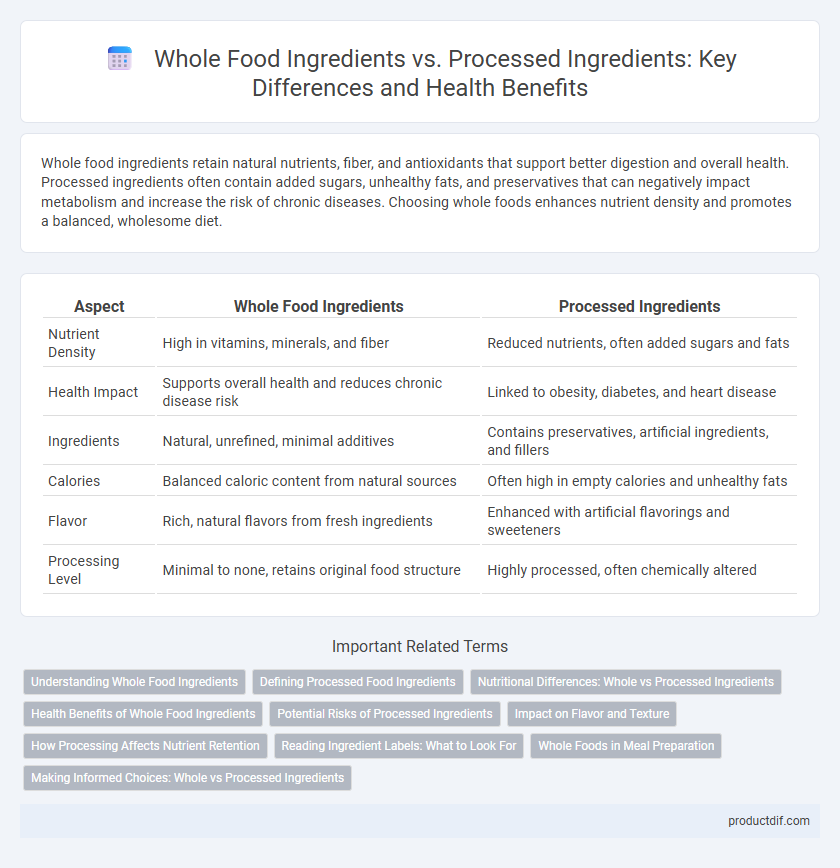Whole food ingredients retain natural nutrients, fiber, and antioxidants that support better digestion and overall health. Processed ingredients often contain added sugars, unhealthy fats, and preservatives that can negatively impact metabolism and increase the risk of chronic diseases. Choosing whole foods enhances nutrient density and promotes a balanced, wholesome diet.
Table of Comparison
| Aspect | Whole Food Ingredients | Processed Ingredients |
|---|---|---|
| Nutrient Density | High in vitamins, minerals, and fiber | Reduced nutrients, often added sugars and fats |
| Health Impact | Supports overall health and reduces chronic disease risk | Linked to obesity, diabetes, and heart disease |
| Ingredients | Natural, unrefined, minimal additives | Contains preservatives, artificial ingredients, and fillers |
| Calories | Balanced caloric content from natural sources | Often high in empty calories and unhealthy fats |
| Flavor | Rich, natural flavors from fresh ingredients | Enhanced with artificial flavorings and sweeteners |
| Processing Level | Minimal to none, retains original food structure | Highly processed, often chemically altered |
Understanding Whole Food Ingredients
Whole food ingredients consist of natural, unrefined products such as fruits, vegetables, whole grains, nuts, and seeds that retain their original nutrients and fiber. These ingredients offer higher vitamin, mineral, and antioxidant content compared to processed ingredients, which often undergo refining, bleaching, or the addition of artificial additives and preservatives. Emphasizing whole food ingredients supports better digestion, improved metabolic health, and reduced risk of chronic diseases associated with nutrient loss in processed foods.
Defining Processed Food Ingredients
Processed food ingredients refer to substances that have undergone physical or chemical transformation from their original state, often including additives, preservatives, flavor enhancers, and artificial colors designed to extend shelf life, improve taste, or alter texture. These ingredients typically lose some nutritional value compared to their whole food counterparts due to refining, bleaching, or hydrogenation processes. Common examples include refined sugars, hydrogenated oils, modified starches, and synthetic flavorings.
Nutritional Differences: Whole vs Processed Ingredients
Whole food ingredients retain higher levels of essential nutrients such as vitamins, minerals, and fiber compared to processed ingredients, which often lose these benefits during refining and cooking. Processed ingredients typically contain added sugars, unhealthy fats, and sodium, contributing to lower overall nutritional quality and potential negative health effects. Consuming whole foods supports better digestion, cardiovascular health, and stable blood sugar levels due to their intact nutrient profile and minimal additives.
Health Benefits of Whole Food Ingredients
Whole food ingredients retain essential nutrients, vitamins, and minerals that are often lost during processing, supporting improved digestion, immune function, and chronic disease prevention. Rich in dietary fiber, antioxidants, and phytochemicals, whole foods promote heart health, reduce inflammation, and help regulate blood sugar levels. Consuming whole food ingredients contributes to optimal nutrient absorption and long-term metabolic health by minimizing exposure to added sugars, preservatives, and unhealthy fats commonly found in processed foods.
Potential Risks of Processed Ingredients
Processed ingredients often contain high levels of added sugars, unhealthy fats, and artificial preservatives that can contribute to chronic diseases such as obesity, diabetes, and heart disease. These ingredients may also harbor contaminants or lose essential nutrients during manufacturing, reducing their overall nutritional value. Consuming whole food ingredients ensures a higher intake of natural vitamins, minerals, and fiber, supporting better health and reduced risk of metabolic disorders.
Impact on Flavor and Texture
Whole food ingredients retain natural flavors and textures, offering a more vibrant and authentic taste experience with diverse mouthfeel sensations. Processed ingredients often lose subtle flavor nuances and develop altered textures, such as increased smoothness or artificial chewiness, due to refinement and additives. The difference in ingredient processing directly influences culinary quality, affecting both flavor complexity and textural integrity in dishes.
How Processing Affects Nutrient Retention
Whole food ingredients retain higher levels of vitamins, minerals, and antioxidants compared to processed ingredients, which often suffer nutrient loss due to exposure to heat, oxygen, and chemicals during manufacturing. Processing methods such as refining, bleaching, and chemical additives degrade essential nutrients like vitamin C, B vitamins, and fiber, reducing the overall nutritional value of the food. Studies show that minimally processed foods preserve fiber content and phytochemicals critical for health, while highly processed foods can lead to nutrient deficiencies when consumed excessively.
Reading Ingredient Labels: What to Look For
When reading ingredient labels, prioritize whole food ingredients that are minimally processed and recognizable, such as fruits, vegetables, nuts, and whole grains. Avoid products with long lists of artificial additives, preservatives, and chemically derived substances like monosodium glutamate (MSG) or high-fructose corn syrup. Understanding ingredient labels helps in selecting nutrient-dense foods that promote better health and reduce the risk of chronic diseases linked to processed food consumption.
Whole Foods in Meal Preparation
Whole foods in meal preparation provide higher nutrient density and better fiber content compared to processed ingredients, enhancing overall health and digestion. These ingredients retain natural vitamins, minerals, and antioxidants crucial for immune support and disease prevention. Using whole foods also reduces exposure to artificial additives, preservatives, and excess sodium found in processed options.
Making Informed Choices: Whole vs Processed Ingredients
Choosing whole food ingredients over processed ingredients enhances nutritional intake by providing higher levels of fiber, vitamins, and minerals essential for optimal health. Whole foods like fresh fruits, vegetables, whole grains, and lean proteins contain fewer additives, preservatives, and unhealthy fats compared to processed foods, which often include refined sugars and artificial components. Making informed choices involves reading labels carefully, prioritizing minimally processed items, and understanding the impact of ingredient quality on overall diet and wellness.
Whole food ingredients vs Processed ingredients Infographic

 productdif.com
productdif.com